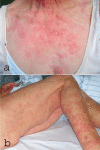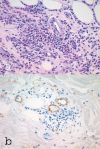Hypocomplementemic urticarial vasculitis syndrome: an interdisciplinary challenge
- PMID: 20019864
- PMCID: PMC2795336
- DOI: 10.3238/arztebl.2009.0756
Hypocomplementemic urticarial vasculitis syndrome: an interdisciplinary challenge
Abstract
Background: Chronic urticaria often points the way to the diagnosis of a systemic disease, particularly when urticarial vasculitis can be demonstrated. Hypocomplementemic urticarial vasculitis syndrome (HUVS) is considered to be an independent immunological disease.
Method: Selective literature review and consideration of the author's own clinical experience.
Results and conclusions: The main manifestation of HUVS is chronic urticarial vasculitis with complement deficiency and the demonstration of C1q antibody in the serum. Multiple other organs are involved, sometimes severely. The diagnosis is confirmed by skin biopsy, which reveals leukocytoclastic vasculitis as a pathogenetic correlate of this systemic disease. Although HUVS is relatively rare, the medical specialists that might encounter it-ophthalmologists, rheumatologists, nephrologists, dermatologists, general practitioners, and pediatricians-should include it in their differential diagnoses whenever appropriate. Awareness of HUVS and rational diagnostic evaluation will lessen the chance of it being misdiagnosed as another type of systemic immunological disease and will reduce superfluous diagnostic testing in patients suffering from it.
Keywords: autoimmune disease; chronic disease; hypocomplementemia; urticaria; vasculitis.
Figures


Comment in
-
Re: Hypocomplementemic urticarial vasculitis syndrome: an interdisciplinary challenge. Recurrent episodes of sudden acute sensorineural hearing loss.Dtsch Arztebl Int. 2010 May;107(19):349; author reply 349. doi: 10.3238/arztebl.2010.0349a. Epub 2010 May 14. Dtsch Arztebl Int. 2010. PMID: 20532130 Free PMC article. No abstract available.
-
Re: Hypocomplementemic urticarial vasculitis syndrome: an interdisciplinary challenge. Question mark over hypocomplementemia.Dtsch Arztebl Int. 2010 May;107(19):349; author reply 349. doi: 10.3238/arztebl.2010.0349b. Epub 2010 May 14. Dtsch Arztebl Int. 2010. PMID: 20532131 Free PMC article. No abstract available.
References
-
- Guha B, Youngberg G, Krishnaswamy G. Urticaria and urticarial vasculitis. Comp Ther. 2003;29:146–156. - PubMed
-
- Davies MD, Daoud MS, Kirby B, Bibson LE, Rogers RS. Clinicopathologic correlation of hypocomplementemic and normocomplementemic urticarial vasculitis. J Am Acad Dermatol. 1998;38:899–905. - PubMed
-
- Mehregan DR, Hall MJ, Gibson LE. Urticarial vasculitis: a histopathologic and clinical review of 72 cases. J Am Acad Dermatol. 1992;26:441–448. - PubMed
-
- Schwartz HR, Mc Duffie FC, Black LF, Schroeter AL, Conn DL. Hypocomplementemic urticarial vasculitis: association with chronic obstructive pulmonary disease. Mayo Clin Proc. 1982;57:231–238. - PubMed
Publication types
MeSH terms
Substances
LinkOut - more resources
Full Text Sources
Medical

